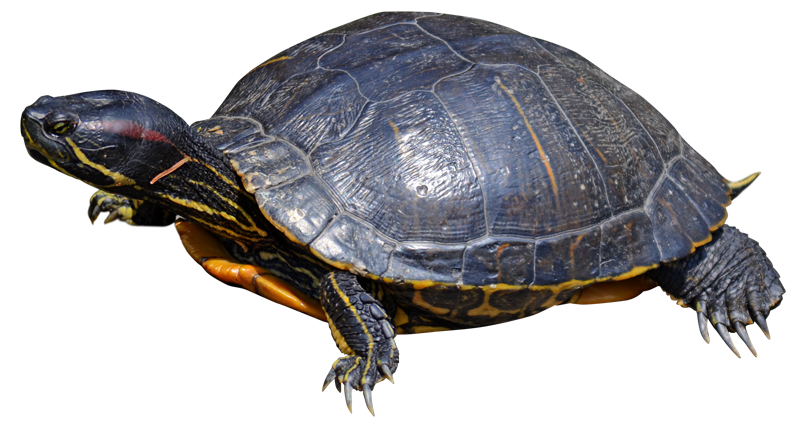
上野動物園内の不忍池で甲羅干しをするミシシッピアカミミガメ
A red-eared slider basking in Shinobazu Pond at Ueno Zoo
Trachemys scripta elegans (Wied-Neuwied, 1839)
国内のカメの約6割を占める外来種
Over 60% of Turtles in Japan are Non-Native Species
14種あるアカミミガメの亜種のひとつです。幼体時は明るい緑色で別名「ミドリガメ」とも呼ばれ、成体になると濃緑色の体に頭部両側に橙赤色の斑紋が入ります。雌の方が大きく最大で甲長28cmになり、雄は体が黒色化することもあります。
原産地はアメリカ合衆国南部からメキシコ北東部の国境近くまでの地域で、主にミシシッピ川水域に生息していることが名前の由来です。全世界的に外来種として野生下で繁殖しており 、IUCNによる「世界の侵略的外来種ワースト100」に名を連ね、各地で取引が規制される存在です。アメリカ合衆国内では輸出は認められていますが、幼体の販売が国内法で禁止されています。また、オーストラリア,韓国,南アフリカ共和国では本亜種の輸入が禁止されています。
日本では1950年代に輸入が始まり、その後露天での販売や景品として配布されることで、おもちゃのような感覚で手に入る存在として人気は高まり、1990年代半ばには年間100万匹もの個体が輸入されるようになりました。しかし、飼えなくなった個体が池や川などに大量に遺棄されたことで日本全域の淡水域で繁殖して、現在は淡水性カメの約6割が本亜種と言われています。法的には2005年の外来生物法の施行時に指定が見送られた経緯があります。2015年に「緊急対策外来種」に指定され、2023年からはアメリカザリガニと共に「条件付特定外来生物」として輸入、販売、そして野外に放つことが法律で禁止され、違反すると罰則・罰金の対象となりました。
彼らは人間の手によって全世界に広がりましたが、それはアカミミガメが生命力が強く適応力高いからこそです。寿命は約40年あり、生後2 – 5年で性成熟し、産卵は年に2 – 3回行います。日本在来種のニホンイシガメは寿命こそ変わりませんが、性成熟に約10年かかり、産卵は年に1 – 2回だけですので、比べると繁殖力の違いが明確です。またアカミミガメの日本における性別個体数は雌の方が多いことも分かっており、数を増やす一因でもあります。多くのカメやワニと同様にアカミミガメは孵卵温度で性別が変わる「温度依存型性決定」であることが知られており、胚発生が26度でおこると雄に、31度では雌になります。つまり温度が高いほど雌が生まれる確率が高くなり、温暖化が進む日本において雌の割合が高いことと関連があるようです。
It is one of the 14 subspecies of the red-eared slider. The young are bright green, and in Japan they are also called “Midori-game” (green turtles). Adults have a dark green body with orange-red spots on both sides of the head. Females are larger than females, reaching a maximum shell length of 28 cm. Males can be black.
The species is native to the southern United States and northeastern Mexico border, mainly living in the Mississippi River basin, from which it was named. It is an invasive species that breeds wild all over the world, and is listed in the IUCN (International Union for Conservation of Nature) “100 of the World’s Worst Invasive Alien Species”, and trade is restricted in various places. In the United States, export is permitted, but the sale of young is prohibited by domestic law. In addition, import of this subspecies is prohibited in Australia, South Korea, and the Republic of South Africa.
Imports to Japan began in the 1950s, and later became popular as toys sold at food stalls and given away as prizes, with as many as one million imported annually in the mid-1990s. However, many were left abandoned in ponds and rivers, and began breeding in freshwater areas throughout Japan, and it is said that about 60% of freshwater turtles today are this subspecies.
Legally, it was not designated when the Invasive Alien Species Act was enacted in 2005, but in 2015 it was designated as a “specified alien species for emergency measures,” and from 2023, along with the American crayfish, it will be prohibited by law to import, sell, or release it into the wild as a “conditional alien species,” and violators will be subject to fines and penalties.
The reason why red-eared sliders have spread around the world by human hands is because they are robust and highly adaptable. They have a lifespan of about 40 years, reach sexual maturity at 2 to 5 years of age, and lay eggs 2 to 3 times a year. The Japanese pond turtle, a native species of Japan, has the same life span, but it takes about 10 years to reach sexual maturity and lays eggs once or twice a year, making the difference in reproductive ability clear. It is also known that there are more female red-eared sliders in Japan, which is one of the reasons for their increasing numbers.
Like many turtles and crocodiles, red-eared sliders are known to have “temperature-dependent sex determination,” meaning that their sex changes depending on the incubation temperature. Embryonic development occurs at 26 degrees, resulting in males, and at 31 degrees, females. In other words, the higher the temperature, the higher the probability of females being born, which seems to be related to the high proportion of females in Japan, where global warming is progressing.
参考文献
国立環境研究所 | 侵入生物データベース | ミシシッピアカミミガメ 2025年6月15日閲覧
環境省 | 日本の外来種対策 | 2023年6月1日よりアカミミガメ・アメリカザリガニの規制が始まりました! 2025年6月15日閲覧
“Have you seen a red-eared slider turtle?” New Pests. 2025年6月15日閲覧
野田 英樹, 大川原 恭祐 「長期的観察による河北潟のアカミミガメ・クサガメ個体群の特徴の変化」 河北潟総合研究 = Kahokugata lake science. 19:2016.6,p.1-6. 2025年6月15日閲覧
Bio-Station | 温度に合わせて性別が決まるメカニズム | (2019年1月22日) 2025年6月15日閲覧
WIRED | 地球温暖化の影響で、アオウミガメは「ほぼすべてメス」になる:研究結果 | (2018年1月22日) 2025年6月15日閲覧
日本自然保護協会 | 記事一覧 | 2023年「日本のカメ一斉調査」の調査結果まとまる アカミミガメ等カメ類の生息状況が分かる | (2024年2月21日) 2025年6月15日閲覧
ミドリガメとフェレット | ミドリガメの歴史(2006年版) 2006-09-03最終更新 2025年6月15日閲覧